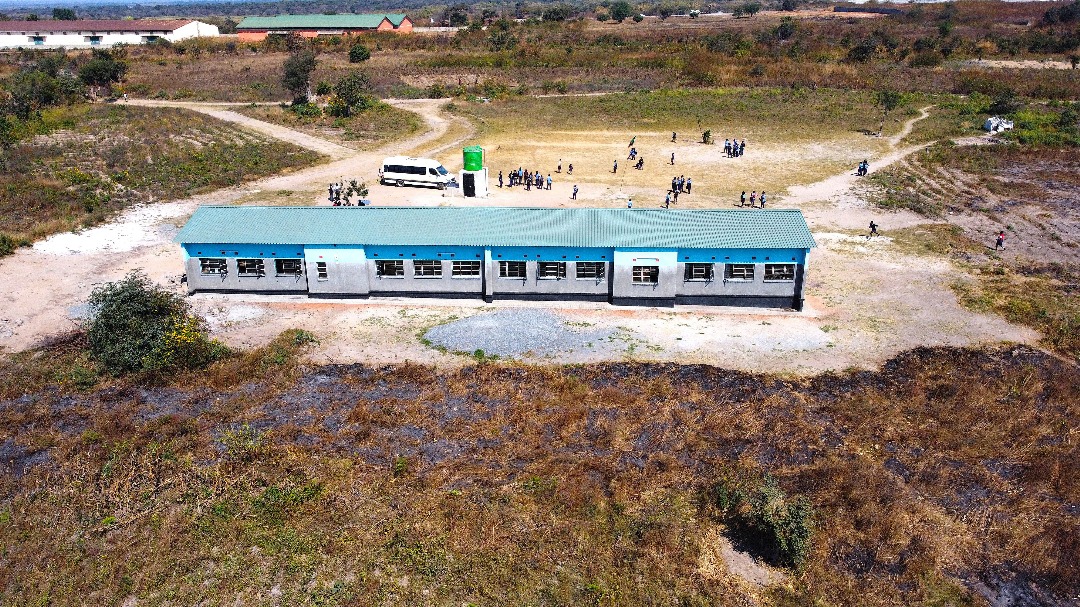NEWTON SIBANDA
Lusaka
WHEN pupils at Namboard Community School in Chambishi sat cross-legged on dusty floors 28 years ago, the future looked uncertain.
Established in 1997 in a former Food Reserve Agency (FRA) warehouse, the school was a grassroots response to a community need.
Its beginnings were humble dim light bulbs, grain sacks, and improvised lessons.
Today, thanks to sustained corporate social responsibility (CSR) efforts led by Chinese mining companies, schools like Namboard have been transformed.
Cracked floors have given way to desks; makeshift classrooms are now permanent structures; and what was once a dream is now reality.
From depot to desks “We started as a community school in 1997 using the FRA depot. We later moved to the Zambia Railways storeroom when FRA renovated their facility,” recalled Patrick Kapambwe, now deputy head teacher.
For years, the lack of a proper learning environment held back enrolment and teacher morale.
That changed when local officials and a businessman secured land—and NFCA (Non Ferrous China Africa) Mining stepped in.
NFCA funded the construction of a 1×4 classroom block under its CSR programme, creating a turning point for Namboard.
Before construction, the school had 448 pupils and 11 teachers. A year after the new block opened, staff increased to 16 and enrolment soared.
“I want to be a doctor,” said 13-year-old Twiza Mwalilino, now in Grade 7.
“We used to sit on the floor. Now we sit comfortably at desks. We thank NFCA.”
Education-focused investment Since 1998, NFCA has invested over US$8 million in CSR initiatives, many focused on health and education.
“Our CSR aligns with government plans. We work where we can make the most impact,” NFCA corporate affairs officer Ma Ruiwen said.
This government-partnered approach ensures investments address genuine community needs not just corporate branding.
School bags and support: ZCCZ’s Model The Zambia-China Economic and Trade Cooperation Zone (ZCCZ) has complemented NFCA’s infrastructure focus by supplying school materials.
At Luela Combined School, pupils once arrived with books clutched in their arms or plastic bags.
ZCCZ distributed 300 school bags, full stationery sets, and K50,000 in support funds.
“I want to be a lawyer and speak for the people. We look forward to science labs and more classrooms,” 14-year-old Joy Thabo Songiso said.
Head teacher Faides Dandule confirmed the impact: “The support is helping learners, especially the school bags. Before, some could only carry two books.”
ZCCZ has adopted an open-door policy, giving each school K50,000 annually and reviewing individual requests.
“We target projects with high impact,” said ZCCZ PR manager Shadreck Lindunda. Parents are grateful.
Helen Mwansa, whose daughter is in Grade four at Luela, noted, “It was hard watching children walk with books in their hands, especially during the rainy season. Now they have dignity.”
CCS: From Classrooms to Clinics Chambishi Copper Smelter (CCS) has invested in both schools and health centres.
It recently built a classroom block at Chambishi Primary and plans another at Chibuluma Combined School.
At Kalulushi General Hospital, CCS renovated the maternity ward, built a modern mother’s shelter, and improved sanitation infrastructure.
“Kalulushi now has the best mother’s shelter in the province. The transformation is remarkable,” Medical Superintendent Dr Mwate Mwambazi, said.
Since 2009, CCS has invested over US$45 million in CSR, focusing on local contractors to generate jobs.
“We act based on community needs,” CCS public relations officer Ethel Musungu said.
CNMC Luanshya Copper Mines (CLM) has restored infrastructure and supported agriculture.
The once-dilapidated H. Figov Road has been repaired, improving access and safety.
CLM also provided small-scale farmers with agricultural inputs and invested in the Sinozam Vocational College of Science and Technology.
Previously offering only craft-level courses, Sinozam now provides diploma-level education.
“Since 2019, we’ve grown significantly. A lot of companies now seek our graduates,” said principal Jorick Yamvwa.
CLM’s US$13 million CSR investment over the past two years has focused heavily on education.
When a head teacher reported that students at Nkulumashima School were learning under a tree, CLM built a 1×3 classroom block.
“This isn’t top-down CSR. We listen to schools and communities and respond,” CLM PR officer Tigomezge Bota said.
Beyond Infrastructure: A development model Together, these four companies—NFCA, ZCCZ, CCS, and CLM—have invested over US$70 million in Copperbelt CSR, focusing on five key pillars: *Education First: Investments range from desks to diploma programmes, boosting Zambia’s human capital. *Community-Led Projects: CSR decisions respond directly to local feedback. *Reinvestment in People: Beyond extracting minerals, these firms are embedding long-term support for communities. *Local Economic Growth: By hiring local contractors and using local resources, projects generate employment. *Stronger Sino-Zambia Relations:
These investments are more than aid—they are partnerships shaping Zambia’s development.
Stories that inspire Twiza Mwalilino, 13, now dreams of becoming a doctor after sitting her first lessons at a real desk.
Joy Thabo Songiso, 14, aspires to law, with her goals fueled by support from ZCCZ.
Helen Mwansa, a parent, sees pride in her daughter’s schoolbag, once a symbol of struggle.
Dr Mwambazi, praises CCS’s maternity ward upgrade as life-changing for mothers.
Jorick Yamvwa, principal at Sinozam, envisions Zambia’s first vocational university emerging from what was once a small training centre.
“These students used to learn under difficult conditions. Now they graduate with real skills,” said Yamvwa.
“Companies scramble for our graduates because they are practically oriented.”
He adds that Zambia needs a national vocational university and Sinozam could lead the way.
“We have the infrastructure; we just need to upgrade. This can be the starting point.”
Building Futures from children once learning on floors, to expectant mothers in crumbling maternity wards Chinese mining-led CSR has altered the narrative.
Today, schools are thriving, clinics are modernising, and young Zambians are learning skills that connect directly to job markets.
What began in a dusty depot in 1997 has grown into a model for collaborative development.
More than corporate duty, this is social investment with long-term vision.
If Copperbelt’s rising classrooms are the blueprint, then Chinese-Zambian CSR is no longer just about extracting minerals—it’s about building futures.


